Radiation Therapy Process
A clinical trial is one of the final stages of a long and careful cancer research process. Studies are done with cancer patients to find out whether promising approaches to cancer prevention, diagnosis, and treatment are safe and effective.
First Visit
Initial Consultation
When radiation therapy is being considered as part of your treatment plan, a consultation visit will be arranged for you with a radiation oncologist, a physician specially trained in using radiation therapy for treating your type of cancer. The purpose of this visit is to discuss the role of radiation therapy in your treatment, to determine the type of radiation therapy to be used, the treatment plan for your treatment, and to answer any questions you may have. All questions will be thoroughly answered to ensure you feel as comfortable as possible about the radiation therapy process.
At this consultation, your provider will obtain a detailed medical history and conduct a physical exam. Your provider may also discuss their findings with other members of the multidisciplinary treatment team so that all treatments, such as surgery and chemotherapy, will be coordinated to ensure that you receive the best possible care. If radiation therapy is not recommended, your provider will discuss the reasons for this. The consultation will take at least one hour, depending on your specific needs.
What to Bring to Your Appointment:
- A complete list of medications, including vitamins, herbal supplements and over-the-counter medication.
- Your insurance card and a picture I.D.
- A family member or close friend to take notes and provide support for you during your appointment.
Informed Consent Process
If radiation therapy is recommended as part of your treatment plan, your provider will review in detail the proposed treatment, the reasons for recommending the treatment, and its potential risks and side effects. Once you feel you have a full understanding of proposed treatment options, as well as the potential risks and side effects, you will be asked to sign a consent form. Before you sign the form, make sure you are completely comfortable with the information you have received. You can withdraw your consent at any time for any reason.
Second Visit
Simulation
Before radiation treatments begin, you will go through a treatment planning process called “simulation.” Through this process, your radiation treatment team will precisely identify the area on your body where you will receive radiation. Positioning is extremely important in radiation therapy and your body will be positioned carefully to ensure you receive the best radiation treatment.
 Next, a computed tomography (CT) scan of the treatment region will be taken. Information from the CT scan is used to precisely locate the treatment fields and create a detailed “map” the provider will use to design your specific treatment plan. The simulation process takes approximately one hour. Since you will be lying on a hard table under the simulator for most of this time, you may experience some pain or discomfort. Should this occur, please tell the radiation technicians. In some instances, an MRI or a PET/CT scan also may be needed and will be ordered by your provider. The information obtained from these scans is used to plan your radiation treatment.
Next, a computed tomography (CT) scan of the treatment region will be taken. Information from the CT scan is used to precisely locate the treatment fields and create a detailed “map” the provider will use to design your specific treatment plan. The simulation process takes approximately one hour. Since you will be lying on a hard table under the simulator for most of this time, you may experience some pain or discomfort. Should this occur, please tell the radiation technicians. In some instances, an MRI or a PET/CT scan also may be needed and will be ordered by your provider. The information obtained from these scans is used to plan your radiation treatment.
Tattoos
During the simulation visit, it is necessary to place about four to eight marks on your skin to outline the treatment field(s). These marks, made with India ink and a needle, look like small tattoos or dots and are the size of a pinpoint or freckle. The process of tattooing causes some temporary discomfort. In some treatment plans, a second set of tattoos may be necessary. While the tattoos are permanent, they are barely noticeable. The tattoos are necessary to make it possible for you to bathe or shower on a daily basis without worrying about removing these important marks.

A drop of India ink is placed on the mark.
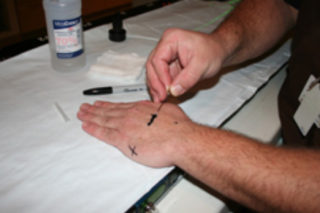
A needle is used to puncture the top layers of the skin, getting the ink under the skin and creating the tattoo.
Immobilization Devices
Depending on the area of the body being treated, an immobilization device may be used. These devices can be in the form of a mask that holds the head in position, or “molds” made out of a foam product that hardens and is molded to hold a particular body part in position. These devices assure the radiation technician that you will remain in the same position for every treatment.
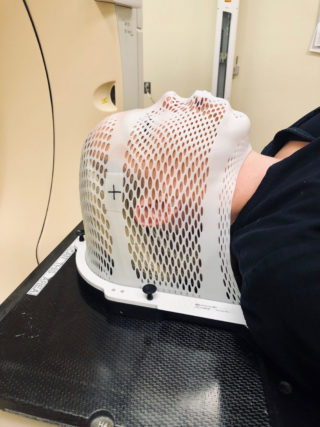
Masks
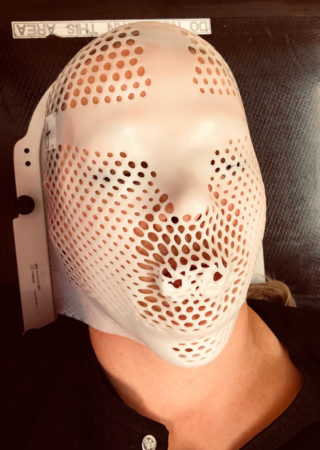
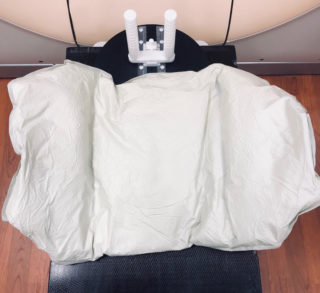
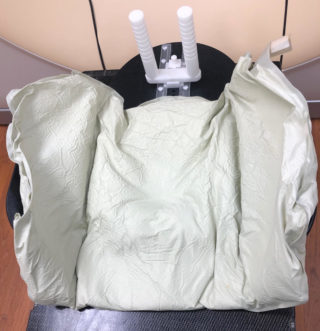
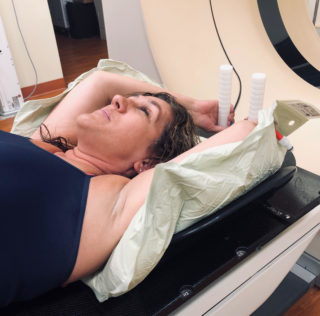
Foam Molds
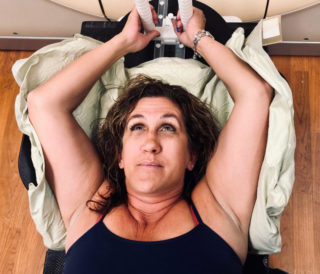
Treatment planning process
After the simulation, details from the procedure are sent to the medical physicist, the radiation oncologist, and the dosimetrist (a member of the radiation oncology team who uses treatment planning computers to generate the radiation plan). These professionals perform highly technical calculations that will be used to set the treatment machine. This treatment planning process can take up to 10 days. Once planning is complete, a therapist will contact you with a date and time to start your treatment.
Second Visit
First Day of Treatment (also known as New Start Date)
A technician will place you on the treatment table in the same position as you were on the simulator. Proper positioning usually takes 20 to 30 minutes. Once positioning is correct, a set of X-rays or a CT scan will be taken. These films will be matched with the simulation films to ensure the treatment is going to be delivered the same way as it was simulated. Occasionally, the match may take some repositioning. In these cases, adjustments will be made and checked by your attending physician. In rare instances, adjustments are required, and treatment might be postponed. This may happen if you have lost a significant amount of weight or the tumor size has changed. Once the films and positioning are confirmed, you will receive your first treatment. The planning and set up time is critical to avoid unnecessary radiation to healthy tissue.
The actual radiation treatment time is approximately 15 to 20 minutes.
Images will be performed daily or weekly to confirm proper positioning. Images are not taken to measure your progress or response to radiation.
Daily Treatments
Once the initial set up is complete, you will be given a daily treatment schedule. Treatments are typically given once a day, Monday through Friday, for a number of weeks. Each treatment generally takes only 15 to 20 minutes; however, you should plan to be in the department for an hour each day.
Before each treatment, the radiation technicians will position you on the treatment table, using the tattoos, immobilization devices, and laser beams on the machine. Once you are set up for your treatment, the technician will go into the control room located just outside the treatment room and give you instructions over a microphone as needed. The radiation technician can see and hear you at all times. As you lie on the treatment table, the table and linear accelerator may move to get the radiation beams in the correct location. Once your position is confirmed, treatment is given. The treatment is not painful and you will not feel anything.
On-Treatment Examinations
Your radiation oncologist and nurse will examine you at least once a week before or after your treatment is administered. These examinations allow your physician and nurse an opportunity to evaluate your physical condition, answer any questions you may have, and coordinate future treatments.
If you are having a problem, do not wait until your next on-treatment exam. Inform your radiation technician immediately and they will notify your physician or nurse. If you are experiencing problems after hours or on the weekend, please call the after-hours answering service at 810-257-2664.
-
Recognize a GHCI Employee for their excellence
Recognize a GHCI Employee for their excellence Want to recognize a GHCI physician, nurse, volunteer or staff member? Please complete…Continue reading »
